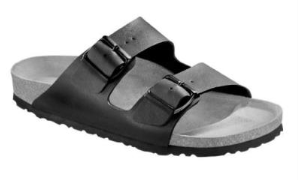Can Shoe Designs be Registered as 3D Trademarks? A Case Study on the Birkenstock Sandals
Date: 14 July 2025
【Volume 153】
In recent years, many brands have sought to expand their trademark protection beyond traditional figurative or word marks into the realm of non-traditional trademarks. Among these, three-dimensional (3D) trademarks regarding product shape become particularly prominent. Classic examples of such registered trademarks include the Taipei 101 building and OREO cookies.1
|
Taipei 101 Building 3D Configuration |
OREO 3-D Cookie Configuration |
|
Reg. No. 01160211 |
Reg. No. 02146093 |
|
|
|
In a 2023 case involving the footwear brand Birkenstock, the Taiwan Intellectual Property Office (TIPO), the Petitions and Appeals Committee, and the court all rejected the application for Birkenstock’s 3D trademark.
Case Fact
In 2019, Birkenstock IP GmbH (hereinafter “Birkenstock”), a well-known German footwear manufacturer, sought to register the 3D shape of their sandal design shown below as a 3D trademark in Taiwan.
|
Rejection No. T0419185, issued in connection with Application No. 108072382 (hereinafter “the Trademark”):
Image source: TIPO Trademark Search System |
However, the Trademark application was rejected by the TIPO in November 2021. Birkenstock filed a petition for review in December 2021, yet it was dismissed by the Petitions and Appeals Committee. Birkenstock then initiated administrative litigation, but the court of the first instance ruled against Birkenstock. Dissatisfied with the judgment, Birkenstock appealed to the Supreme Administrative Court, which again ruled against Birkenstock.
Summary of Judgments and Decisions by the Supreme Administrative Court:
The following summarizes the Rejection Decision issued by the TIPO, the Petition Rejection Decision by the Petitions and Appeals Committee, the Administrative Judgment of the Intellectual Property and Commercial Court (2022 Xing Shang Su Zi No. 47), and the Administrative Judgment of the Supreme Administrative Court (2023 Shang Zi No. 55):
(1) Footwear is an everyday consumer good, and consumers generally exhibit a lower level of attention when making purchasing decisions. Therefore, for the appearance of a shoe product to possess inherent distinctiveness, it must exhibit a relatively high degree of unique design.
(2) The “metal buckle strap” and other elements claimed by Birkenstock are considered as merely basic design features. Online search results also show that products from other brands have shoes with similar appearances and functional designs. Although Birkenstock emphasizes that the 3D shape also includes elements such as contoured footbeds and patterned soles, these are still common ergonomic and anti-slip features found in ordinary footwear. As such, these features pertain to the product’s appearance, functionality, or related characteristics, and are insufficient to establish that the Trademark possesses inherent distinctiveness.
(3) According to the market survey report submitted by Birkenstock, the sampling was limited to the Greater Taipei Metropolitan area, excluding other regions of Taiwan. Moreover, respondents were shown both images of the shoes and a list of brand names when answering the questions, rather than being asked to identify Birkenstock’s design based solely on their first impression of the shoe images. Even with such aided hints, only 58% of the respondents were able to correctly identify the brand. The result indicates that the sample size in which a consumer is capable of recognizing the product’s source based on the 3D shape of the shoe is insufficient.
Ultimately, in 2023, the court of the second instance once again ruled against Birkenstock, holding that the original judgment made by the court of the first instance should be upheld.
Wisdom Analysis
As of March 2025, the majority of successfully registered 3D trademarks in Taiwan involved container shapes, product packaging, and character designs. Currently, for footwear, successful registrations concerning 3D shapes of shoes are typically limited to specific design elements or portions bearing brand marks. For the overall shape of the shoe body, including features such as straps, applicants are often required to disclaim exclusive rights. This reflects the high likelihood that standard 3D shapes of shoes may continue to be viewed as lacking distinctiveness. Thus, for the protection of 3D shapes, we recommend that applicants file both a 3D trademark and a design patent. Alternatively, applicants may prioritize filing for a design patent before public disclosure.
[1] 2024 Statistics on Non-Traditional Trademarks (in Traditional Chinese) (https://www.tipo.gov.tw/trademarks-tw/lp-583-201.html)







